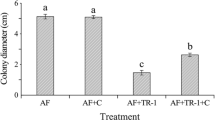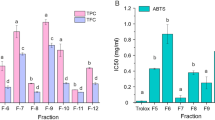Abstract
Aflatoxin is a mycotoxin and the most potent naturally occurring carcinogen in many animals. Aflatoxin contamination of food and feed crops causes a significant global burden on human and animal health. However, available methods to eliminate aflatoxin from food and feed are not fully effective. Our goal is to discover novel, efficient, and practical methods to control aflatoxin contamination in crops during storage. In the present study, we tested the effect of volatiles produced by willow (Salix acutifolia and Salix babylonica) and maple (Acer saccharinum) bark on fungal growth, development, and aflatoxin production by the fungus Aspergillus parasiticus, one economically important aflatoxin producer. S. acutifolia bark volatiles nearly eliminated aflatoxin accumulation (>90% reduction) by A. parasiticus grown on a minimal agar medium. The decrease in aflatoxin accumulation correlated with a twofold reduction in ver-1 (encodes a middle aflatoxin pathway enzyme) transcript level. Expression data also indicate that one histone H4 acetyltransferase, MYST3, may play a role in epigenetic control of aflatoxin gene transcription in response to volatile exposure. Volatiles derived from wood bark samples also increased fungal growth up to 20% and/or enhanced conidiospore development. Solid-phase microextraction–gas chromatographic–mass spectrometric analysis of bark samples identified sets of shared and unique volatile compounds that may mediate the observed regulatory effects on growth, development, and aflatoxin synthesis. This work provides an experimental basis for the use of willow industry by-products to control aflatoxin contamination in food and feed crops.




Similar content being viewed by others
References
Abanda-Nkpwatt D, Krimm U, Coiner HA, Schreiber L, Schwab W (2006) Plant volatiles can minimize the growth suppression of epiphytic bacteria by the phytopathogenic fungus Botrytis cinerea in co-culture experiments. Environ Exp Bot 56:108–119
Adams TH, Yu JH (1998) Coordinate control of secondary metabolite production and asexual sporulation in Aspergillus nidulans. Curr Opin Microbiol 1:674–677
Amaike S, Keller NP (2009) Distinct roles for VeA and LaeA in development and pathogenesis of Aspergillus flavus. Eukaryot Cell 8:1051–1060
Aziz NH, Moussa AE (1997) Influence of white light, near-UV irradiation and other environmental conditions on production of aflatoxin B-1 by Aspergillus flavus and ochratoxin A by Aspergillus ochraceus. Nahrung-Food 41:150–154
Aziz NH, Smyk B (2002) Influence of UV radiation and nitrosamines on the induction of mycotoxins synthesis by nontoxigenic moulds isolated from feed samples. Nahrung 46:118–121
Bahn YS, Xue C, Idnurm A, Rutherford JC, Heitman J, Cardenas ME (2007) Sensing the environment: lessons from fungi. Nat Rev Microbiol 5:57–69
Bayram O, Krappmann S, Ni M, Bok JW, Helmstaedt K, Valerius O, Braus-Stromeyer S, Kwon NJ, Keller NP, Yu JH, Braus GH (2008) VelB/VeA/LaeA complex coordinates light signal with fungal development and secondary metabolism. Science 320:1504–1506
Bennett JW (2009) Aspergillus: a primer for the novice. Med Mycol 47(Suppl 1):S5–S12
Bennett JW, Klich M (2003) Mycotoxins. Clin Microbiol Rev 16:497–516
Berndsen CE, Denu JM (2008) Catalysis and substrate selection by histone/protein lysine acetyltransferases. Curr Opin Struct Biol 18:682–689
Biksey TM, Wu F (2009) Biofuels: by-products. Science 326:1344–1345
Bothast RJ, Bennett GA, Vancauwenberge JE, Richard JL (1992) Fate of fumonisin B(1) in naturally contaminated corn during ethanol fermentation. Appl Environ Microbiol 58:233–236
Buchanan RL, Lewis DF (1984) Caffeine inhibition of aflatoxin synthesis: probable site of action. Appl Environ Microbiol 47:1216–1220
Buchholtz T, Volk TA, Abrahamson L, Smart L (2008) An economic analysis tool for willow short-rotation coppice for wood chip production. SUNY-ESF Willow Biomass Program. Available at http://www.esf.edu/willow/
Butchko RA, Adams TH, Keller NP (1999) Aspergillus nidulans mutants defective in stc gene cluster regulation. Genetics 153:715–720
Calvo AM (2008) The VeA regulatory system and its role in morphological and chemical development in fungi. Fungal Genet Biol 45:1053–1061
CAST (2003) Mycotoxins: risks in plant, animal, and human systems. Council for Agricultural Science and Technology, Ames
Chanda A, Roze LV, Kang S, Artymovich KA, Hicks GR, Raikhel NV, Calvo AM, Linz JE (2009) A key role for vesicles in fungal secondary metabolism. Proc Natl Acad Sci USA 106:19533–19538
De Sordi L, Mühlschlegel FA (2009) Quorum sensing and fungal-bacterial interactions in Candida albicans: a communicative network regulating microbial coexistence and virulence. FEMS Yeast Res 9:990–999
Dvorackova I, Kusak V (1990) Hepatocellular carcinoma (a 28-year necropsy review). J Environ Pathol Toxicol Oncol 10:220–224
Fiebich BL, Chrubasik S (2004) Effects of an ethanolic salix extract on the release of selected inflammatory mediators in vitro. Phytomedicine 11:135–138
Fries N (1960) Nonanal as a growth factor for wood-rotting fungi. Nature 187:166–167
Georgianna DR, Payne GA (2009) Genetic regulation of aflatoxin biosynthesis: from gene to genome. Fungal Genet Biol 46:113–125
Gochenaur SE, Whittingham WF (1967) Mycoecology of willow and cottonwood lowland communities in Southern Wisconsin. I. Soil microfungi in the willow-cottonwood forests. Mycopathol Mycol Appl 33:125–139
Greene-McDowelle DM, Ingber B, Wright MS, Zeringue HJ Jr, Bhatnagar D, Cleveland TE (1999) The effects of selected cotton-leaf volatiles on growth, development and aflatoxin production of Aspergillus parasiticus. Toxicon 37:883–893
Gunterus A, Roze LV, Beaudry R, Linz JE (2007) Ethylene inhibits aflatoxin biosynthesis in Aspergillus parasiticus grown on peanuts. Food Microbiol 24:658–663
Hong SY, Linz JE (2009) Functional expression and sub-cellular localization of the early aflatoxin pathway enzyme Nor-1 in Aspergillus parasiticus. Mycol Res 113(5):591–601
Huang JQ, Jiang HF, Zhou YQ, Lei Y, Wang SY, Liao BS (2009) Ethylene inhibited aflatoxin biosynthesis is due to oxidative stress alleviation and related to glutathione redox state changes in Aspergillus flavus. Int J Food Microbiol 130:17–21
Jiang Y, Jolly PE, Preko P, Wang JS, Ellis WO, Phillips TD, Williams JH (2008) Aflatoxin-related immune dysfunction in health and in human immunodeficiency virus disease. Clin Dev Immunol 2008:790309
Kenstaviciene P, Nenortiene P, Kiliuviene G, Zevzikovas A, Lukosius A, Kazlauskiene D (2009) Application of high-performance liquid chromatography for research of salicin in bark of different varieties of Salix. Medicina (Kaunas) 45:644–651
Koptina AV, Shyrgin AI, Kanarskiy AV, Kanarskaya ZA, Tarasova EY, Tremasov MY (2009) Efficacy of willow bark Salix acutifolia to absorb T-2 mycotoxin. IVUZ Forest Journal 6:146–151 (in Russian)
Koptina AV, Shyrgin AI, Kanarskiy AV (2010) Salicilates extraction from willow bark Salix acutifolia (Salicaceae). Plant Resour 1:67–71 (in Russian)
Liang S-H (1996) The function and expression of the ver-1 gene and localization of the Ver-1 protein involved in aflatoxin B1 biosynthesis in Aspergillus parasiticus. Ph.D. thesis, Michigan State University, East Lansing, MI, USA
Lillehoj EB, Lagoda A, Maisch WF (1979) The fate of aflatoxin in naturally contaminated corn during the ethanol fermentation. Can J Microbiol 25:911–914
Liu Y, Wu F (2010) Global burden of aflatoxin-induced hepatocellular carcinoma: a risk assessment. Environ Health Perspect 118:818–824
Mendgen K, Wirsel SGR, Jux A, Hoffmann J, Boland W (2006) Volatiles modulate the development of plant pathogenic rust fungi. Planta 224:1353–1361
Nahrstedt A, Schmidt M, Jäggi R, Metz J, Khayyal MT (2007) Willow bark extract: the contribution of polyphenols to the overall effect. Wien Med Wochenschr 157:348–351
Norrman J (1968) Morphogenetic Effects of some volatile organic compounds on Pestalotia rhododendri. Arch Mikrobiol 61:128–142
Nyman B (1969) The effect of various aliphatic aldehydes and related compounds on the growth of Dipodascus aggregatus. Physiol Plant 22:1322–1328
Palmer JM, Keller NP (2010) Secondary metabolism in fungi: does chromosomal location matter? Curr Opin Microbiol 13:431–436
Roze LV, Calvo AM, Gunterus A, Beaudry R, Kall M, Linz JE (2004) Ethylene modulates development and toxin biosynthesis in Aspergillus possibly via an ethylene sensor-mediated signaling pathway. J Food Prot 67:438–447
Roze LV, Arthur AE, Hong SY, Chanda A, Linz JE (2007a) The initiation and pattern of spread of histone H4 acetylation parallel the order of transcriptional activation of genes in the aflatoxin cluster. Mol Microbiol 66:713–726
Roze LV, Beaudry RM, Arthur AE, Calvo AM, Linz JE (2007b) Aspergillus volatiles regulate aflatoxin synthesis and asexual sporulation in Aspergillus parasiticus. Appl Environ Microbiol 73:7268–7276
Roze LV, Chanda A, Laivenieks M, Beaudry RM, Artymovich KA, Koptina AV, Awad DW, Valeeva D, Jones AD, Linz JE (2010) Volatile profiling reveals intracellular metabolic changes in Aspergillus parasiticus: veA regulates branched chain amino acid and ethanol metabolism. BMC Biochem 11:33
Sharma A, Padwal-Desai SR, Nadkarni GB (1985) Possible implications of reciprocity between ethylene and aflatoxin biogenesis in Aspergillus flavus and Aspergillus parasiticus. Appl Environ Microbiol 49:79–82
Shimizu K, Hicks JK, Huang TP, Keller NP (2003) Pka, Ras and RGS protein interactions regulate activity of AflR, a Zn(II)2Cys6 transcription factor in Aspergillus nidulans. Genetics 165:1095–1104
Skvortsov AK (1999) Willows of Russia and adjacent countries. Available at http://www.salicicola.com/announcements/skv/page1-4.pdf
Smith AT, Tucker-Samaras SD, Fairlamb AH, Sullivan WJ Jr (2005) MYST family histone acetyltransferases in the protozoan parasite Toxoplasma gondii. Eukaryot Cell 4:2057–2065
Song J, Fan LH, Beaudry RM (1998) Application of solid phase microextraction and gas chromatography time-of-flight mass spectrometry for rapid analysis of flavor volatiles in tomato and strawberry fruits. J Agric Food Chem 46:3721–3726
Stora C, Dvorackova I (1987) Aflatoxin, viral hepatitis and primary liver cancer. J Med 18:23–41
Trail F, Mahanti N, Linz J (1995) Molecular biology of aflatoxin biosynthesis. Microbiology 141(Pt 4):755–765
Vlachojannis JE, Cameron M, Chrubasik S (2009) A systematic review on the effectiveness of willow bark for musculoskeletal pain. Phytother Res 23:897–900
Volk TA, Abrahamson LP, White EH, Neuhauser E, Gray E, Demeter C, Lindsey C, Jarnefeld J, Aneshansley DJ, Pellerin R, Edick S (2000) Developing a willow biomass crop enterprise for bioenergy and bioproducts in the United States. Available at http://bioenergy.ornl.gov/papers/bioen00/volk.html
Woloshuk CP, Foutz KR, Brewer JF, Bhatnagar D, Cleveland TE, Payne GA (1994) Molecular characterization of aflR, a regulatory locus for aflatoxin biosynthesis. Appl Environ Microbiol 60:2408–2414
Wright MS, Greene-McDowelle DM, Zeringue HJ, Bhatnagar D, Cleveland TE (2000) Effects of volatile aldehydes from Aspergillus-resistant varieties of corn on Aspergillus parasiticus growth and aflatoxin biosynthesis. Toxicon 38:1215–1223
Zeringue HJ Jr (2000) Identification and effects of maize silk volatiles on cultures of Aspergillus flavus. J Agric Food Chem 48(3):921–925
Zeringue HJ Jr, McCormick SP (1990) Aflatoxin production in cultures of Aspergillus flavus incubated in atmospheres containing selected cotton leaf-derived volatiles. Toxicon 28:445–448
Zeringue HJ, Brown RL, Neucere JN, Cleveland TE (1996) Relationships between C-6–C-12 alkanal and alkenal volatile contents and resistance of maize genotypes to Aspergillus flavus and aflatoxin production. J Agric Food Chem 44:403–407
Zonneveld BJM (1988) Effect of carbon dioxide on fruiting in Aspergillus nidulans. Trans Br Mycol Soc 91:625–629
Acknowledgements
This work was supported by National Institutes of Health Grant CA52003-18 (to J.E.L. and L.V.R.), the Michigan Agricultural Experiment Station, and the President of Russian Federation Scholarship (to A.V.K.).
Author information
Authors and Affiliations
Corresponding author
Rights and permissions
About this article
Cite this article
Roze, L.V., Koptina, A.V., Laivenieks, M. et al. Willow volatiles influence growth, development, and secondary metabolism in Aspergillus parasiticus . Appl Microbiol Biotechnol 92, 359–370 (2011). https://doi.org/10.1007/s00253-011-3339-7
Received:
Revised:
Accepted:
Published:
Issue Date:
DOI: https://doi.org/10.1007/s00253-011-3339-7




